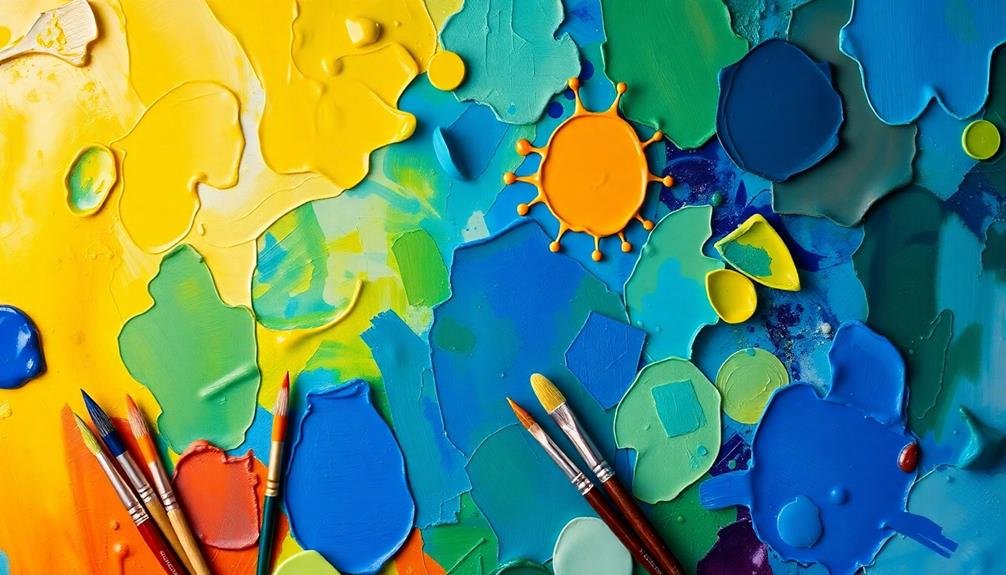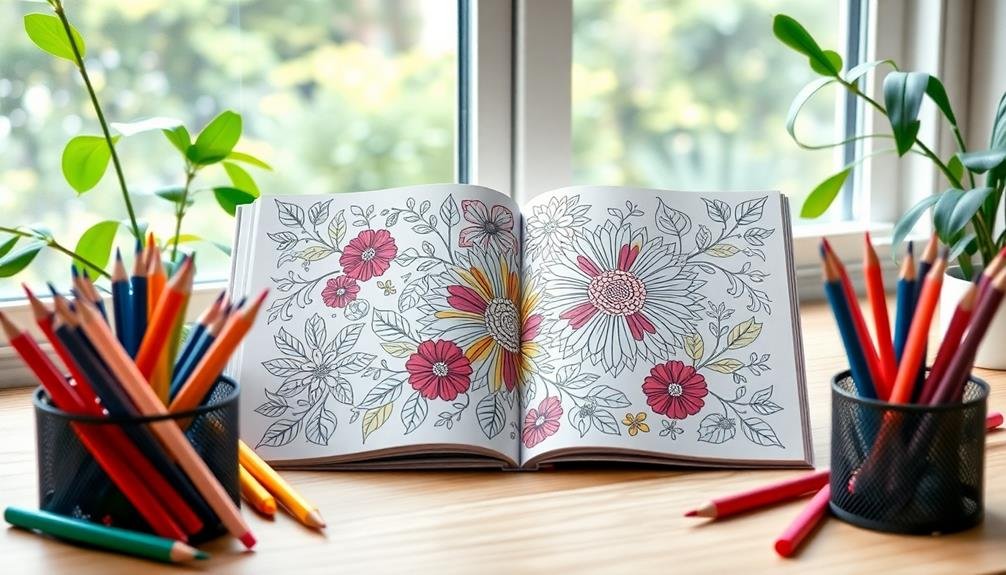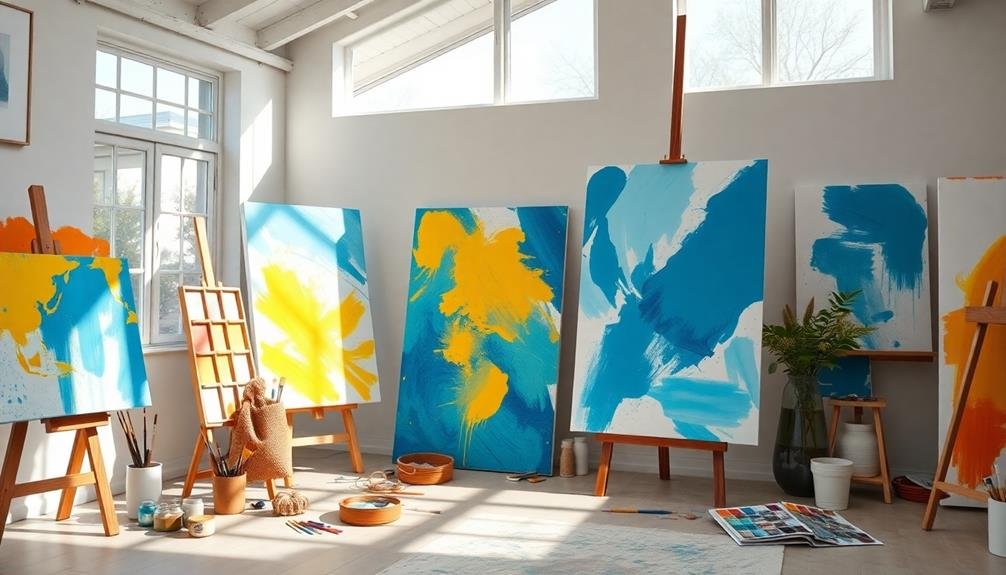To heal through color in art therapy, start by understanding color psychology. Each color evokes specific emotions, so choose ones that resonate with your current feelings. Engage in creative activities like painting or coloring, allowing yourself to express and release bottled-up emotions. Create a calming space to enhance relaxation, using soft lighting and soothing sounds. Incorporate mindfulness techniques, focusing on your breath and the emotions colors inspire. Ultimately, track your progress by documenting your artwork and feelings. By embracing this colorful journey, you'll discover pathways to emotional healing and insight into your inner world. There's much more to explore!
Understanding Color Psychology

In the world of art therapy, color psychology plays an essential role in how you process emotions and experiences. Each color evokes different feelings and responses, influencing your mood and well-being. For instance, warm colors like red and orange can energize you, sparking excitement or even anger.
On the other hand, cool colors such as blue and green tend to promote calmness and tranquility, helping you feel relaxed and centered.
When you engage in art therapy, think about the colors you choose. Are you drawn to vibrant hues, or do you prefer softer pastels? Your color selections can reveal underlying emotions that might be difficult to express verbally.
By exploring these preferences, you can gain insights into your emotional state.
Additionally, consider how colors interact with one another on your canvas. Contrasting colors can represent conflict or tension, while harmonious combinations may symbolize balance and peace.
Understanding these dynamics can deepen your self-awareness and aid in your healing journey.
Ultimately, recognizing the power of color in your art can help you navigate complex feelings, providing a pathway to understanding and self-discovery.
The Benefits of Art Therapy
Art therapy offers you a powerful way to express and release emotions that might be difficult to articulate in words.
By engaging in creative activities, you can also discover effective stress reduction techniques that promote relaxation and well-being.
Let's explore how these benefits can transform your emotional landscape.
Emotional Expression and Release
Emotional release often emerges as a powerful benefit of engaging in art therapy. When you pick up a brush or mold clay, you tap into emotions that might be difficult to express verbally. This creative process allows you to externalize feelings like sadness, anger, or joy, transforming them into visual forms. By expressing your emotions through art, you create a safe space to explore and confront what's been bottled up inside.
You might find that colors and shapes resonate with your experiences, offering an immediate channel for expression. Each stroke or layer can symbolize a part of your emotional journey, giving you insight into your inner world. As you create, you may also discover new perspectives on your feelings, leading to a deeper understanding of yourself.
Moreover, the act of creating can be liberating. It encourages you to let go of judgments and expectations, fostering a sense of authenticity. You're free to express yourself without the constraints of language, which can be incredibly cathartic.
Ultimately, art therapy provides a unique opportunity for emotional expression and release, empowering you to navigate your feelings and heal in a profound way.
Stress Reduction Techniques
Through the creative process, you can greatly reduce stress and anxiety. Engaging in art therapy allows you to immerse yourself in colors and forms that express your feelings, helping to release pent-up emotions. When you focus on creating, your mind shifts away from stressors, providing a mental break.
Using specific stress reduction techniques within art therapy can enhance your experience. For instance, try coloring mandalas or abstract patterns. The repetitive motions and focus required can be meditative, calming your mind and lowering your heart rate.
You might also explore painting your emotions, using colors that resonate with how you feel. This not only offers a release but also helps you understand your emotional landscape better.
Incorporating breathing exercises while creating can further amplify relaxation. Take deep breaths, inhale as you choose colors, and exhale as you make strokes. This synchronization of breath and creativity promotes mindfulness, anchoring you in the present moment.
Ultimately, art therapy is a powerful tool for stress reduction. By allowing yourself to create freely, you can find peace, clarity, and a renewed sense of self. Embrace the journey, and let your creativity guide you toward healing.
Choosing the Right Colors

Selecting the right colors for your art therapy session can greatly impact your healing journey. Colors evoke emotions and can either uplift or calm your spirit. When you choose colors, consider what feelings you want to explore or express.
Here are three key points to help you choose effectively:
- Identify Your Emotions: Think about how you're feeling right now. Are you experiencing sadness, anger, or joy? Different colors resonate with different emotions. For example, blue can evoke calmness, while red might express passion or anger.
- Consider Color Meanings: Familiarize yourself with basic color psychology. Green represents healing and balance, yellow promotes happiness and optimism, and purple is often associated with spirituality. Use this knowledge to guide your choices.
- Trust Your Instincts: Ultimately, your intuition is your best guide. If a color speaks to you or resonates deeply, don't hesitate to incorporate it into your artwork. Your personal connection to a color can enhance your therapeutic experience and facilitate deeper healing.
Techniques for Color Application
Bringing color into your artwork can be a transformative experience, so it's essential to explore various techniques for applying it effectively. One approach is layering, where you build up colors gradually to create depth and richness. Start with lighter shades and add darker ones to enhance shadows and highlights.
Another technique is blending, which allows colors to merge seamlessly. You can use your fingers, brushes, or even sponges to achieve a smooth shift between hues. Don't shy away from experimenting with different materials, such as pastels, watercolors, or acrylics, each offering unique blending properties.
Dabbing is a fun method too—using a sponge or a brush to apply color in small, random spots creates texture and visual interest. If you want to add drama, try contrasting colors; their placement can evoke strong emotions and draw attention to specific areas.
Lastly, consider using washes, where you dilute your paint with water for a translucent effect. This technique can evoke feelings of calmness and serenity.
Exploring Coloring Books

Coloring books can be a powerful tool for relaxation and self-expression.
You'll want to contemplate the benefits of different types of books, how to choose one that resonates with you, and effective techniques to enhance your experience.
Let's explore how these elements can enrich your art therapy journey.
Benefits of Coloring Books
Have you ever wondered how something as simple as a coloring book can impact your well-being? Coloring books aren't just for kids; they offer several benefits that can enhance your mental health and emotional balance.
Here are three compelling reasons to pick up a coloring book today:
- Reduces Stress: Engaging with colors and patterns can help lower anxiety levels. As you focus on filling in shapes, you divert your mind from worries and create a sense of calm.
- Enhances Creativity: Coloring allows you to explore your artistic side without the pressure of perfection. You get to choose colors and styles freely, which can spark new ideas and boost your creative thinking.
- Improves Focus: The repetitive motion of coloring can promote mindfulness. You become more present in the moment, which can enhance your concentration and clear your mind of distractions.
Incorporating coloring into your routine can be a simple yet effective way to nurture your mental health.
Choosing the Right Book
Selecting the right coloring book can greatly enhance your experience and benefits from this creative outlet. First, consider your personal interests. Do you enjoy intricate patterns, nature scenes, or abstract designs? Choose a book that resonates with you, as this connection can deepen your engagement.
Next, think about your skill level. If you're just starting, opt for simpler images. As your confidence grows, you can challenge yourself with more complex designs. This progression keeps your experience enjoyable and fulfilling.
Also, pay attention to the paper quality. Thicker pages are better for various coloring mediums, preventing bleed-through and allowing you to experiment with markers, gel pens, or colored pencils.
Don't forget to explore different themes, such as mandalas, animals, or inspirational quotes. Each theme can evoke different emotions and set the tone for your creative session.
Lastly, consider the overall size of the book. A larger format allows for more detailed work, while a smaller book is portable and convenient for coloring on the go.
Techniques for Effective Coloring
Mastering effective coloring techniques can transform your art therapy experience into a more enriching and therapeutic journey. By utilizing specific approaches, you can engage deeply with your creativity and emotions.
Here are three techniques to enhance your coloring practice:
- Mindful Coloring: Focus entirely on the act of coloring. Pay attention to the colors you choose and the movements of your hand. This mindfulness can help reduce stress and promote relaxation.
- Color Psychology: Understand the emotional impact of colors. For instance, blue can evoke calmness, while yellow can inspire happiness. Choose colors that resonate with your current feelings or desired emotional state.
- Layering Techniques: Experiment with layering different colors to create depth and texture. This method not only enhances your artwork but also allows you to express complex emotions through visual depth.
Incorporating these techniques into your coloring practice can deepen your connection to the art, making it a powerful tool for healing.
Creating a Relaxing Environment
Creating a relaxing environment is essential for maximizing the benefits of art therapy. Begin by choosing a quiet space where you won't be easily disturbed. Clear away any clutter that might distract you, and set up your art supplies in an organized manner.
Consider soft lighting; natural light is ideal, but if that's not possible, use warm or dimmable lamps to create a soothing atmosphere.
Next, incorporate calming colors into your environment. Soft blues, greens, or pastels can promote tranquility. You might also want to add plants or nature-inspired decor to enhance the feeling of peace.
Sound matters too; play gentle background music or nature sounds to help you unwind.
Don't forget to control the temperature—ensure it's comfortable, as being too hot or cold can be distracting.
Finally, consider using aromatherapy. Essential oils like lavender or chamomile can promote relaxation and focus, allowing you to immerse yourself fully in your art.
Integrating Mindfulness Practices

Integrating mindfulness practices into your art therapy sessions can greatly enhance your creative experience and emotional healing. Mindfulness allows you to stay present, fostering a deeper connection with your emotions and the colors you're using.
Here are three simple ways to incorporate mindfulness into your sessions:
- Breath Awareness: Before you start creating, take a few moments to focus on your breath. Inhale deeply through your nose, hold it for a moment, and exhale slowly through your mouth. This can help ground you and clear your mind.
- Color Exploration: As you choose your colors, take the time to notice how each one makes you feel. What emotions arise? Allow yourself to be fully aware of these feelings without judgment.
- Mindful Observation: While working on your art, periodically pause to observe your piece. Notice the shapes, colors, and textures. Engage your senses—what sounds do you hear, what does the paint feel like on your fingers?
Personalizing Your Art Therapy
Personalizing your art therapy experience can greatly amplify its healing effects. Start by choosing colors that resonate with your emotions. If you're feeling calm, opt for blues and greens; if you're looking for energy, vibrant reds and yellows might be your go-to. This connection between color and emotion can create a powerful, personalized narrative in your artwork.
Next, consider the medium you want to work with. Whether it's painting, drawing, or collage, select what feels most comfortable and enjoyable for you. Engaging with a medium you love can enhance the therapeutic process and make it more meaningful.
Think about your environment, too. Create a dedicated space that inspires you, filled with items that spark joy or comfort.
This space should reflect your personality and preferences, allowing you to immerse yourself fully in the experience.
Tracking Your Progress

Tracking your progress in art therapy can be a transformative part of your healing journey. By regularly evaluating your growth, you can identify patterns, celebrate achievements, and address challenges.
Here are three effective ways to track your progress:
- Create a Visual Journal: Document your artwork and reflections in a dedicated journal. Include dates and any emotions tied to each piece, allowing you to see your evolution over time.
- Set Specific Goals: Establish clear, achievable goals for your art therapy sessions. Whether it's experimenting with new techniques or expressing certain emotions, having goals helps you stay focused and motivated.
- Reflect Regularly: Schedule time to review your past artworks and journal entries. Reflection deepens your understanding of your emotional journey and highlights areas where you've grown.
Frequently Asked Questions
Can Children Participate in Color Therapy Activities?
Absolutely, children can participate in color therapy activities! They often express themselves through colors, allowing you to explore their emotions and thoughts creatively. Engaging them in these activities can foster self-expression and emotional awareness.
Are There Any Age Restrictions for Art Therapy?
There aren't strict age restrictions for art therapy; it's often tailored to individual needs. You can engage with various age groups, from young children to seniors, ensuring everyone benefits from the creative process.
How Often Should I Practice Art Therapy for Effectiveness?
You should practice art therapy regularly, ideally several times a week. Consistency boosts effectiveness, helping you explore emotions and thoughts deeply. Listen to yourself; find a rhythm that feels right and beneficial for your healing journey.
Is It Necessary to Have Artistic Skills for Art Therapy?
You don't need artistic skills for art therapy. It's about expressing your feelings and exploring emotions, not creating a masterpiece. Just let your creativity flow—it's the process that matters, not the final product.
Can Color Therapy Help With Specific Mental Health Conditions?
Yes, color therapy can help with specific mental health conditions. You might find that certain colors evoke emotions or memories, aiding your healing process by promoting relaxation, reducing anxiety, or enhancing mood in meaningful ways.
In Summary
Incorporating color into your art therapy journey can be a powerful way to heal and express yourself. By understanding color psychology and choosing colors that resonate with you, you can reveal emotional benefits and enhance your creativity. Whether you explore coloring books or create your own masterpieces, remember to personalize your experience and integrate mindfulness practices. As you track your progress, you'll discover not just a path to healing, but a deeper connection to your own emotions.





Leave a Reply